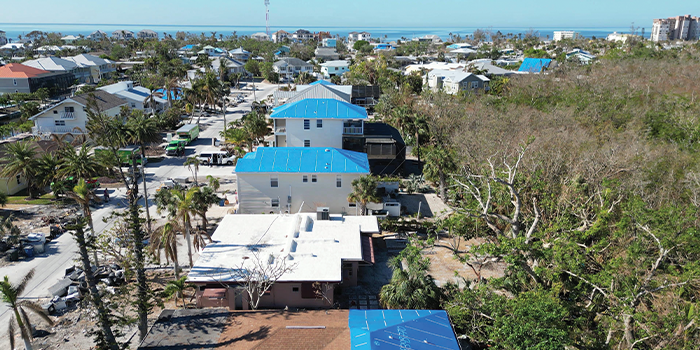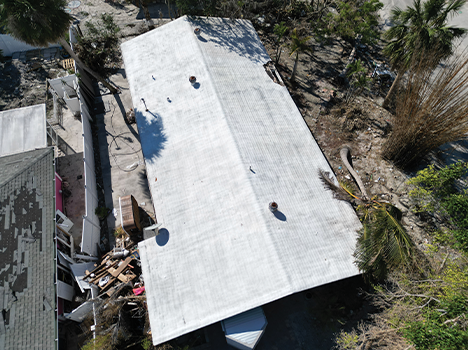Last One’s Standing


SPRAY FOAM MAGAZINE – As Hurricane Ian’s threatening force geared up to be a direct hit on the Gulf Coast of Florida, Governor Ron DeSantis said, “Pray for people,” adding that Ian was of “historic” proportions. Floridians prepared as best they could for a storm that was so colossal, the entire state faced warnings about its possible effects. At just past 3 PM on Wednesday, September 28, 2002, Ian slammed into the Southern Gulf Coast as a Category 4 storm, killing 149 people.
The storm’s 155-mile-per-hour winds, (just short of the threshold for Category 5 hurricane), coupled with the storm surge, hit the area of Fort Myers, which took the biggest punches Ian delivered. The Spray Foam Magazine team (SFMT) caught up with veteran spray foam applicator and Fort Myers resident, Dan Maxwell. We wanted to know how the roofs fared following the storm, especially those with SPF installed.
The Contractor
Situated on a barrier island, Fort Myers is known for its soft white sands, turquoise sea, watersports, and beach lifestyle. Surrounded by smaller islands like Sanibel and the Captiva islands, the area brings in numerous tourists every year, who are looking for their slice of paradise. Dan Maxwell, owner of Maxwell Urethane Roofing, Inc, has been spraying urethane since 1980. He trained at NCFI in North Carolina and has been a member of the SPFA for many years with several of their certifications. He’s had his business now for 23 years. When it comes to doing things right in the industry, he is a perfectionist every step of the way, from the prep to application. His business works on both residential and commercial projects in his local area, and in the past, he has also traveled all over the U.S. helping fellow spray companies as a hired gun.
Maxwell stayed with family when the hurricane landed and waited patiently until it passed. The house he was staying in had a shingle roof and by the time the hurricane had gone, there were buckets all over the floor to help contain the water that had leaked through the roof. As soon as it was safe to leave his shelter, Maxwell made a point of going out and taking photos of the damaged roofs. He noticed the roofs with spray polyurethane foam installed fared very well, especially the ones that were coated with silicone and embedded granules. He explained, “The SPF roofs that had any damage tended to be the ones that had damage from other factors. For example, there was an SPF roof that had no damage except for a Norfolk Island pine that had speared the roof.”
Maxwell wanted to focus on the older urethane roofs and how they fared during Hurricane Ian. “I wanted to show people the 10- to 12-year-old roofs as opposed to a new one. The new roofs look great, but we needed to see how the older roofs stood the test of time.”
The Roofing Industry Committee on Weather Issues, Inc.
As with previous years, RICOWI, Inc. sends teams to investigate the conditions of roofs in the areas impacted by Hurricanes. Reports on these extreme weather events have then been published and are available at www.ricowi.com (at the time of this article, the report following hurricane Ian, was still being finalized). This valued information gained from prior investigations has helped guide the investigation of roof damage for the next hurricane.
RICOWI deploys teams to hurricane-damaged areas if they meet the following criteria: sustained wind speeds of 95 mph or greater at landfall in the continental United States, as well as demonstrate significant damage to populated areas. Generally, team members are wind engineers, roofing material specialists, insurance analysts, structural engineers, and/or roofing consultants. Some teams included roofing contractors or other interested parties who aided in arranging inspections or in providing access and equipment.

An approximately two-year-old urethane roof with silicone and granules completely intact in between several heavily damaged ‘blue roofs’ in the heart of Ft Myers Beach; BELOW: A 23-year-old urethane roof with acrylic coating held up in the estimated 150 mph winds. The small section on far side of the building that did blow away was actually the metal roof underneath. The urethane held to the metal, which was found in the trees nearby.
David Roodvoets is an independent contractor, and his role in the RICOWI storm investigations is to organize the field investigations and coordinate and assemble the investigation report. The SFMT spoke with David about the investigation following Hurricane Ian, specifically related to SPF roofing. “Hurricane Ian made landfall on September 28, 2022, and the Scout team was on site from October 11th – 13th. Deployment was announced on October 14th, with the inspection teams’ arrival starting on October 24th and deployed on Tuesday, October 25th. The inspections were completed by the morning of October 28th. In previous full-scale investigations, our full teams would have been deployed by October 13th, but initial aerial views showed little debris and damage except for the barrier islands that were considered inaccessible.”
In former complete RICOWI investigations, they had five or more teams with representatives from almost all phases of the roofing industry, including: academic researchers, insurance researchers, wind engineers, code officials, architects, and Federal Emergency Management Agency (FEMA) representatives. This was therefore considered a mini-investigation as they did not have at least four active inspection teams on the ground for four days. The program ran from Tuesday through Friday, with Tuesday morning devoted to orientation and assignment.
The team makeup for Hurricane Ian consisted of three teams of four people with each team having an independent roof consultant in addition to the independent consultant. One team had two metal roof industry members and a roofing contractor association representative. One team had two members of a national research lab and a roofing manufacturer representative, and one team had an additional independent roofing consultant, a member representing a metal roofing association, a manufacturer of roofing components and an independent roofing contractor. The Scout team had two independent consultants and two roofing manufacturer representatives.

After minimal damage to this roof from a fallen coconut tree, repairs were made and silicone and granules added to restore the roof, which saved the homeowner the huge expense of rebuilding.
How did SPF Roofs fare?
RICOWI has had inspection teams observing roof damage after seven hurricanes starting in 2004. They have observed that most spray foam roofs stay in place; therefore, they are not obviously seen as damaged roofs and do not draw the attention of the inspection teams.
When RICOWI encounters spray foam roofs following a hurricane, it is when a team is directed to an address, or it is noticed in an area inspection. The damage is likely to be minor and not obvious from aerial views.
During the RICOWI Ian inspections, two spray foam roofs were observed. The roofs were aggregate coated and lacked any type of edge stop or parapet. This resulted in significant aggregate movement along the roof edges and aggregate loss. The foam appeared to be nearly complexly intact with a few blisters opened. Although no definitive data was obtained, it could be assumed that these roofs were not leaking and would not be difficult to repair.
In some past RICOWI hurricane investigations, spray foam roofs were observed to have had significant damage as the foam was attached to substrates that were not well attached to a roof deck or building structure. Attachment of all components is critical in windstorms and there must be a solid load path to the foundation. Contractors need to know that the SPF is being attached to something that is solid and well connected to the structure.
Get Trained
Certified spray foam contractors must be aware that being certified for residential and commercial applications does not mean they are qualified to install an SPF roof. There are many aspects of SPF roofing that can go wrong if a spray foam contractor is not trained. Here are just a few things to consider:
Surface prep: Check the material where the SPF is being applied to and if it has any chemicals on it. Does it need pressure washing, sandblasting, or vacuuming? Does it need a primer?
Make sure the drainage is correct: SPF roofing systems can deal with small amounts of water but water that stands for a period can have a damaging effect on the coating.
Flashing: SPF roofing leaks usually due to incorrect flashing. For example, the drains, gutter, parapets, and edging detail are all crucial. Therefore, being knowledgeable in roof flashing techniques is imperative.
Wrong system: Applying the wrong foam, coating or membrane can and has happened.
Attachment: Make sure whatever the foam is being applied to is securely attached to the structure. Old roof decks often were not attached according to current code and are vulnerable to wind.
It is therefore essential for a certified SPF contractor wanting to add SPF roofing to their range, to:
Train in SPF roofing application
Train in roofing practices and principles
Understand the limitations of weather (extra time and material needed)
New equipment (consider a larger capacity proportioner and coating equipment to help increase the volume of daily production. Other equipment needed: generator, compressors, roof cleaning equipment, coating equipment, ladders, fall protection equipment, wind screens, skylight covers, debris removal chutes, and more)
Experience
Less than a year after Hurricane Ian touched down on the Gulf Coast of Florida, many residents of Fort Myers, and the surrounding areas, are still battling with insurance companies for a fair payout to rebuild their roofs. There is still a lot of rebuilding to be completed, however, many spray foam roofing systems observed stayed intact and those damaged were either due to debris piercing the roofing system or poor installation resulting in failures. With observant contractors like Dan Maxwell and the professional analysis of the RICOWI teams, future storms and their impact on SPF roofs will help verify that SPF roofing stems applied by a professional and certified contractor will weather any storm.
For use by SprayFoamMagazine.com & Spray Foam Magazine
Disqus website name not provided.









































